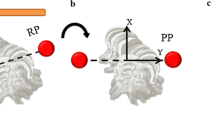Summary
Three-dimensional (3-D) reconstructions of the spine are being used with increasing frequency to describe scoliotic deformities, but the reproducibility of most of these techniques and the implication for the reliability of measurements made on the reconstructions has not been reported. How reliable are these reconstructions, and can a clinician interpret with confidence the results of studies based on such mathematical models? A reproducibility study of various computerised measurements obtained from 3-D reconstructions of the spine and rib cage for five subjects with adolescent idiopathic scoliosis was done to evaluate the errors associated with repeated measurements and compare them with inter-and intraobserver errors reported for similar commonly used clinical measurements. The mean variation for the Cobb angle differed according to the plane of computation from 0.6° in the frontal plane to 6.7° in the sagittal plane; vertebral axial rotation varied from 2.3° to 5.9° according to the vertebral level, and rib hump measurements displayed an average variation of 1.4°. All these variations are below or within the error levels reported for equivalent 2-D measurements used by clinicians, which suggests that this 3-D model of idiopathic scoliosis may be used with confidence for clinical evaluations.
Similar content being viewed by others
References
André B, Dansereau J, Labelle H (1992) Effect of radiographic landmark identification errors on the accuracy of 3-D reconstruction of the human spine. Med Biol Eng Comput 30: 569–575
Beekman CE, Hall V (1979) Variability of scoliosis measurement from spinal roentgenograms. Phys Ther 59:764–765
Carman DL, Browne RH, Birch JG (1990) Measurement of scoliosis and kyphosis radiographs. J Bone Joint Surg [Am] 72:328–333
Dansereau J, Beauchamp A, de Guise J, Labelle H (1990) 3-D reconstruction of the spine and rib cage from stereoradiographic and imaging techniques. Proceedings of Canadian Society of Mechanical Engineering 2:61–64
Dansereau J, Papillon B, Labelle H (1990) Corrected 3-D parametric model of reconstructed scoliotic spines. Proceedings of 14th Annual Meeting of American Society of Biomechanics, pp 105–106
Dansereau J, Stokes IAF (1988) Measurements of the 3-D shape of the rib cage. J Biomech 21:893–901
Goldberg M, Poitras B, Mayo N, Labelle H, Bourassa R, Cloutier R (1988) Observer vatiation in assessing spinal curvature and skeletal development in adolescent idiopathic scoliosis. Spine 13:1371–1377
Jeffries BF, Tartlon M, Devyer SJ, Brower AC (1980) Computerized measurements and analysis of scoliosis. Pediatr Radiol 134:381–385
Koreska J, Smith JM (1982) Portable desktop computer-aided digitiser system for the analysis of spinal deformities. Med Biol Eng Comput 20:715–726
Labelle H, Dansereau J, de Guise J, André B, Beauchamp A (1990) 3-D parametric reconstruction of the spine and rib cage from stereoradiographic and imaging techniques. In: Cotrel Y (ed) Proceedings of Seventh International Congress on C-D Instrumentation. Sauramp Medical, pp 15–20
Marzan GT (1976) Rational design for close range photogrammetry. PhD thesis, Department of Civil Engineering, University of Illinois at Urbana-Champaign
Morrissy RT, Goldsmith GS, Hall EC, Kehl D, Cowie GH (1990) Measurement of the Cobb angle on radiographs of patients who have scoliosis. J Bone Joint Surg [Am] 72:320–327
Mubarak SJ, Wyatt MP, Leach J (1984) Evaluation of the intra-examiner reliability of the scoliometer in measuring trunk rotation. Orthop Trans 9:113
Oda M, Sauh S, Gregory PB, Silverman FN, Bleck EE (1982) The significance of roentgenographic measurement in scoliosis. J Pediatr Orthop 2:378–382
Perdriolle R, Vidal J (1985) Thoracic idiopathic scoliosis curve evolution and prognosis. Spine 10:785–791
Russell GG, Raso J, Hill D, McIvor J (1990) A comparison of four computerised methods for measuring vertebral rotation. Spine 15:24–27
Stokes IAF, Bigalow LC, Moreland MS (1986) Measurement of axial rotation of vertebrae in scoliosis. Spine 11:213–218
Stokes IAF, Shuman-Hartswick D, Moreland S (1988) Spine and back shape changes in scoliosis. Acta Orthop Scand 59: 128–133
Ylikoski M, Tallroth K (1990) Measurement of variations in scoliotic angle, vertebral rotation, vertebral body height, and intervertebral disc space height. J Spinal Disord 3:387–391
Author information
Authors and Affiliations
Rights and permissions
About this article
Cite this article
Labelle, H., Dansereau, J., Bellefleur, C. et al. Variability of geometric measurements from three-dimensional reconstructions of scoliotic spines and rib cages. Eur Spine J 4, 88–94 (1995). https://doi.org/10.1007/BF00278918
Received:
Revised:
Accepted:
Issue Date:
DOI: https://doi.org/10.1007/BF00278918



